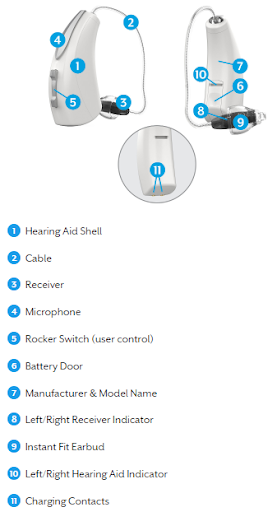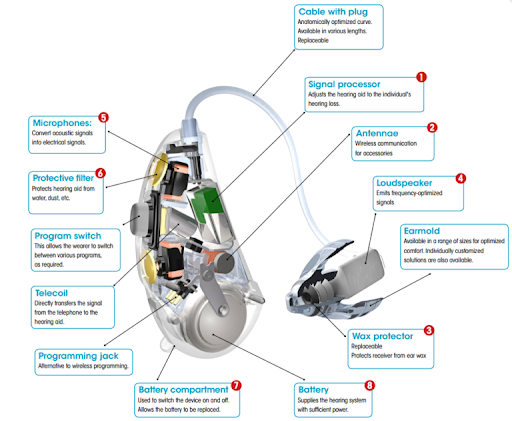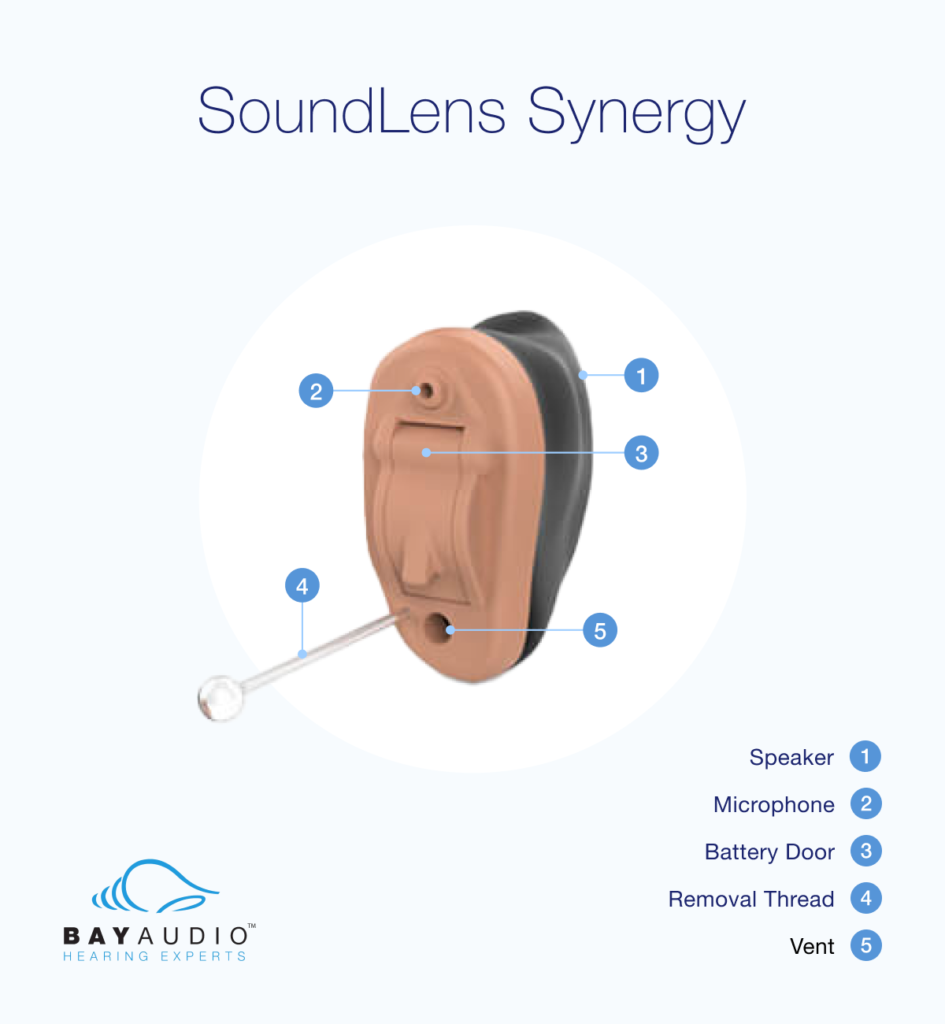Hearing aid technology provides people with hearing loss the invaluable opportunity to connect with their world. Although you don’t need to be an expert in audiology to enjoy the many benefits of wearing a hearing aid, it does help to know a little bit about their parts and how they work.
In this article, we’ll provide diagrams and explanations to help you understand more about hearing aid parts, as well as explaining the range of available hearing solutions for people with a hearing impairment.
Main Components: Internal Parts Of A Hearing Aid
Hearing aids are very small electronic devices that are designed to magnify sound vibrations within the ear. Although there are many different digital hearing aid styles, they will all feature a microphone, amplifier, speaker, and power source as the main components.
Let’s take a closer look at these parts to understand how hearing aids function:
- Microphone: The microphone picks up sound waves and converts these into digital signals which are then sent to an amplifier. Depending on the hearing aid type, some microphones are able to differentiate between speech and background noise, to help the user understand conversation in noisy settings.
- Amplifier: The amplifier works by increasing the strength of the digital signals, and sending them to the speaker. The strength of the amplification will depend on the severity of the user’s hearing loss.
- Speaker: The speaker produces amplified sound into the ear. Inside the inner ear are tiny hair cells that can detect vibrations, which are then converted into neural signals that the brain processes as sound.
- Power source: Hearing aids are powered by batteries, which will either be disposable or rechargeable depending on the model.
Secondary Components of a hearing aid
These secondary hearing aid components are features of certain models, but not all. Your hearing health professional will make a recommendation about the type of hearing aid that’s best for you, depending on your level of hearing loss and your own personal preferences.
Visit our hearing aid page to learn about the full range of hearing solutions Bay Audio offers.
- Volume and memory control : The volume control feature of a hearing aid allows the user to adjust the loudness level. This is a useful feature to have, since it allows you to turn down the volume if you’re in a noisy environment (such as at a live music or sporting event), or up if you’re in a quiet setting.
- If your hearing aid has a memory control feature, you’ll be able to automatically switch the volume to a saved setting. It’s useful to be able to program in a range of different volume preferences and give them labels such as ‘home’, ‘school’, etc. Depending on your hearing aid model, you might be able to control these settings via a Bluetooth connection to your smartphone.
- Ear hook: Behind-The-Ear (BTE) hearing aids feature a piece of transparent plastic which loops over the top of the ear to keep the device secure.
- Earmold: This is the part of the hearing aid that sits inside your ear. To make sure that your hearing aid fits snugly within your ear, your hearing specialist might take an impression of your external ear cavity to create a personalised earmold.
- Vent: The vent is a small hole that runs through the earmold to prevent ear infections and alleviate the sensation of having a blocked ear.
- Wax guard: The wax guard component is a filter that keeps the electrical components of the hearing aid free from wax.
- Telecoil: Certain types of hearing aids feature a magnetic sensor called a telecoil or t-coil. Designed to enhance the hearing experience, the telecoil facilitates connectivity between the hearing aid and external audio sources such as PA systems. If you’re attending a public venue that has the necessary technology, telecoils enable the hearing aid to work as a personal speaker for a public sound system.
Hearing Aids Parts Diagram
Bay Audio offers a range of hearing aids featuring sophisticated designs and cutting-edge technology. The main kinds of hearing aids we offer are:
- Behind The Ear (BTE)
- Receiver In The Ear Canal (RITC)
- In The Ear (ITE)
- In The Canal (ITC)
- Completely In the Canal (CIC)
- Invisible Open Technology (IOT)
- Open Ear Fitting (OEF)
Let’s take a closer look at the inner workings of various hearing aid types, so you can have a better understanding of how they function.
Behind The Ear (BTE) hearing aids

credit: Livio AI
This type of hearing aid features a curved design that fits snugly behind the ear. It also has an earmold that fits inside your ear, and a clear tube to direct sound into the inner ear.
Behind The Ear models are the most common types of hearing aids, and they’re best suited to those with smaller ear canals. Bay Audio offers two types of BTE hearing aids:
Receiver In The Ear Canal (RITC) hearing aids
This diagram shows the typical configuration of a RITC hearing aid:

credit: Livio AI
The hearing aid parts for Receiver In The Ear Canal (RITC) models are fairly similar to the Behind The Ear models. The main difference between the two styles is that RITC hearing aids house a receiver inside the ear canal, so sound is delivered directly to the eardrum.
Here’s another view of the typical configuration of a RITC hearing aid:

credit: Livio AI
The RITC style is available from Bay Audio in the following models:
In The Ear (ITE) hearing aids
This diagram shows the internal parts of a ITE hearing aid:

credit: Livio AI
Designed to fit comfortably in your ear, In The Ear (ITE) hearing aids feature a more discreet design compared with the BTE and RITC styles. These types of hearing aids also usually feature larger batteries, which means you don’t have to charge them as often. Plus, they enable a wide range of handy electronic features.
Bay Audio offers this style of ITE hearing aid:
Parts of In the Canal (ITC) hearing aids
This diagram shows the ITC hearing aid parts:
 credit: Livio AI
credit: Livio AI
These types of hearing aids feature a custom design that allows for them to be fitted discreetly inside the ear canal. Because In The Canal (ITC) hearing aids fit directly inside the ear canal, they offer clear sound with little interference.
The ITC style is available from Bay Audio in the following styles:
Parts of Completely In The Canal (CIC) hearing aids
These are the internal parts of a CIC hearing aid:

The Completely In The Canal (CIC) style of hearing aid is an even more discreet version of the ITC style. These devices are designed to fit entirely within the ear canal, so they’re even more hidden from external view.
Bay Audio offers the CIC style of hearing aid with this model:
Parts of Invisible Open Technology (IOT) hearing aids
This diagram shows the IOT hearing aid parts:

Hearing aids that use Invisible Open Technology (IOT) are the world’s smallest. They are entirely hidden from view, designed to totally blend in with your ear. Plus, they’re very comfortable to wear.
The IOT hearing aid is available at Bay Audio in the following models:
Parts of Open Ear Fitting (OEF) hearing aids
This diagram shows the parts of a OEF hearing aid:

credit: Livio AI
The Open Ear Fitting (OEF) style of hearing aid is a miniature version of the Behind the Ear (BTE) and Receiver In The Ear Canal (RITC) styles. Sound is transmitted directly through a thin tube that’s attached to a tip which sits comfortably in your ear canal.
These models are called ‘open’ because the earpiece doesn’t fit tightly inside the ear canal. Because the ear canal is not obstructed, you get a more natural sound with an ‘open’ feeling.
What type of hearing aid is right for me?
If you have concerns about your hearing, it’s easy to book a hearing test at Bay Audio. Our experienced and qualified clinical team can provide you with guidance and hearing solutions to suit your needs.
Make a booking enquiry today to discuss your hearing aid options with a friendly team member.


